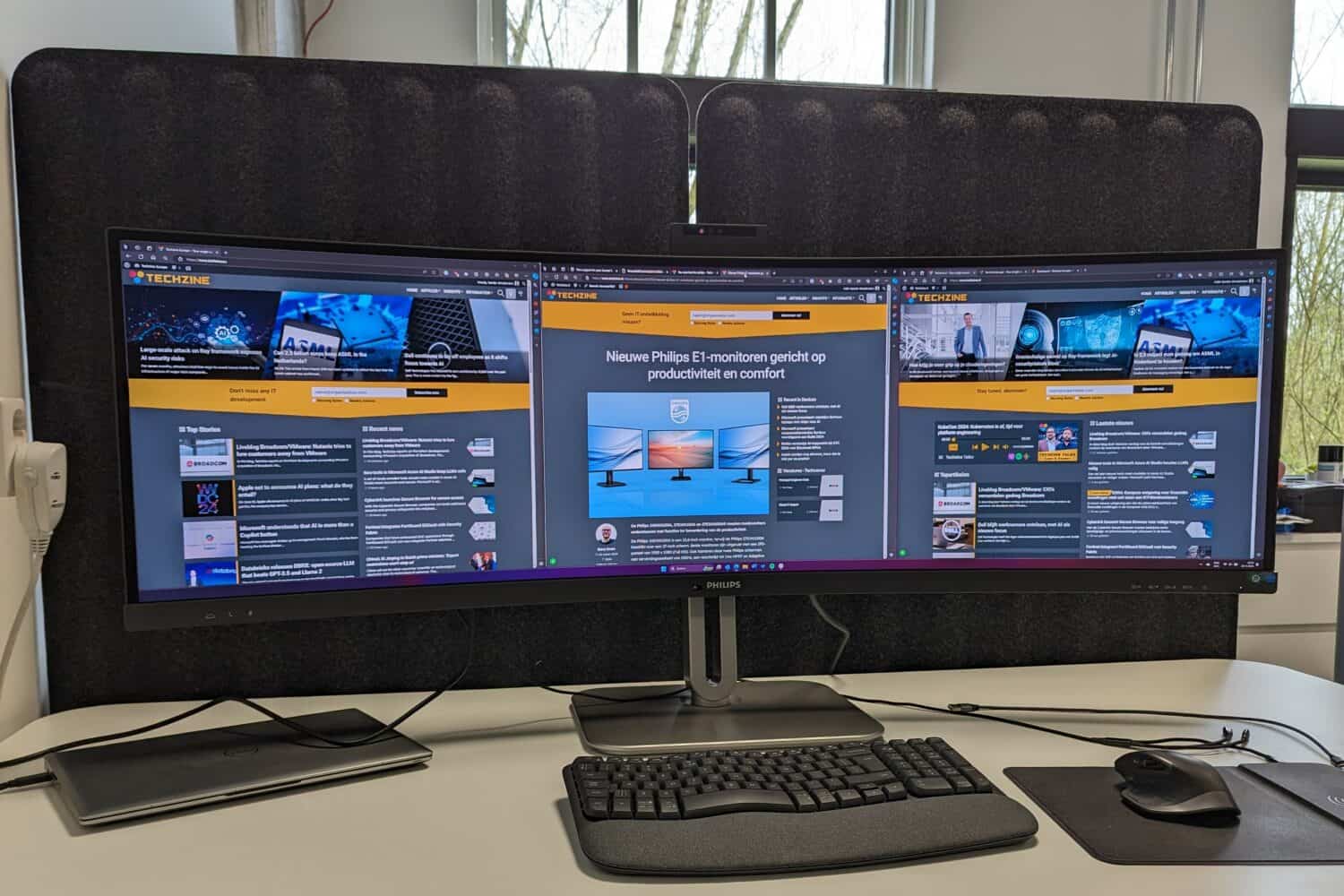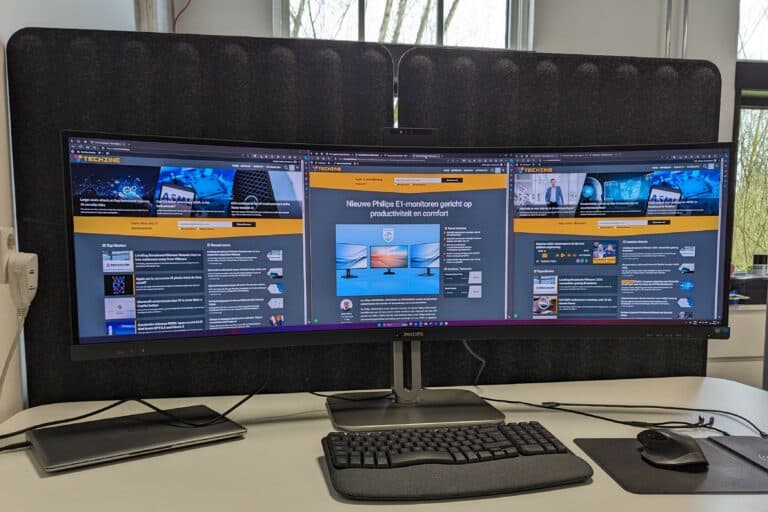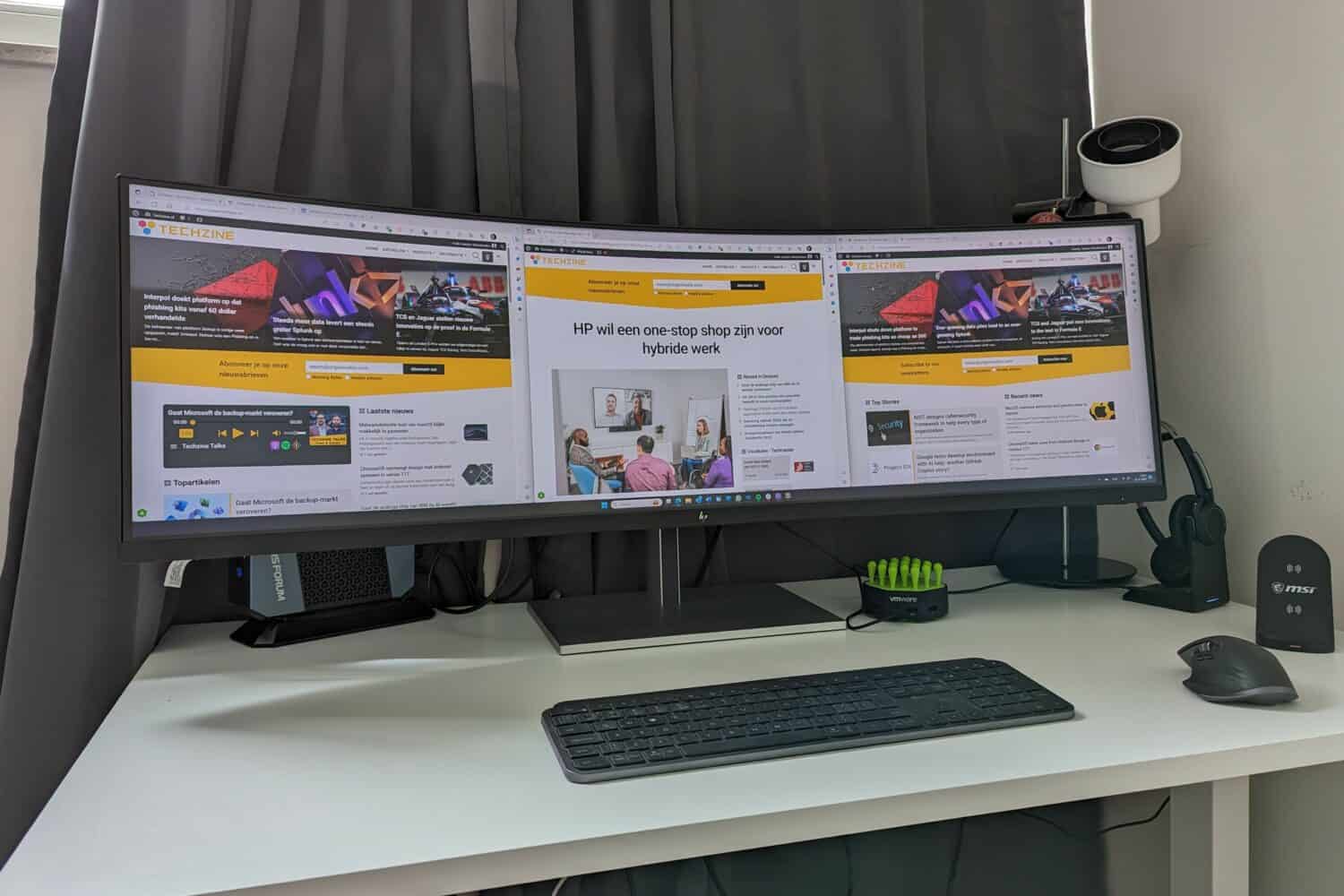Would you like to put a big monitor on your desk? Then you can go for a seriously large model like the HP E45c G5. This monitor has a screen diagonal of 44.5 inches. However, if you still don’t think that’s big enough, then you can also look at the Philips 49B2U6900CH, with a screen diagonal of 48.8 inches. We worked with both models for a while and report on our experiences in this article.
At the beginning of this review, we want to make it clear right away that, fundamentally, we like having a large Ultrawide monitor on our desk. Ever since the first models came on the market about ten years ago, we have been using this type of monitor. We have adapted our work process to it quite a bit. For example, we have long used PowerToys’ FancyZones functionality to divide an Ultrawide screen into three compartments instead of two, which was the only possibility in Windows until relatively recently.
Until now, however, we were working on Ultrawide models up to about 34 inches. We did not get a chance yet to get our hands on Super Ultrawide (or SuperWide) monitors of the size of the HP E45c G5 and the Philips 49B2U6900CH. Is bigger actually better? And of course, which of the two do we prefer? These are some of the questions we have tried to find answers to. As will become apparent, there are quite a few similarities between the two devices, but also some notable differences, beyond the size difference.
HP E45c G5: hardware
As already indicated, the HP E45c G5 is a monitor with a screen diagonal of 44.5 inches. That’s 113 centimeters. The panel has a so-called DQHD resolution of 5120×1440 pixels. This gives it an aspect ratio of 32:9, or twice the aspect ratio of 16:9 known from the laptop world. The refresh rate of the screen is excellent at 165 Hz, even in the highest resolution of 5120×1440. Maximum brightness is also fine at 400 nits.
The HP E45c G5 is a curved screen, hence the “c” in the name. The panel has a 1500R curvature. With that, it has quite a hefty curve. Not as generous as the 1000R seen mostly on gaming monitors, but definitely more curved than an 1800R panel (like the Philips 49B2U6900CH in this article). For those who want to know, the numbers in 1000R, 1500R, 1800R represent the radius (half the diameter) of a circle you would make using monitors with one of these curves if you put them in a circle. The more curved the monitor, the smaller the circle and therefore the smaller the radius: 1000mm, 1500mm, 1800mm.
As a screen technology, we find a VA panel in the HP E45c G5. This is a technology generally known for the high contrast it delivers because of its good black levels. On that score, it outperforms IPS panels as a rule. The HP E45c G5 has a contrast ratio of 3000:1. There’s nothing wrong with that. VA panels do not have as good viewing angles as IPS panels and are generally a bit less exuberant in color reproduction. Because of the curve, this monitor does a good job of presenting a consistent image to the user. There’s no significant shift in brightness or color reproduction due to the viewing angle at which you view the panel. If you sit directly in front of it, you will only see a little bit of reduced brightness toward the extreme side edges. This is due to the viewing angle.
Furthermore, the HP E45c G5 has an all-around decent number of connectors. We see four times USB-A, two of which are at the bottom of the screen. The latter is handy, because you can easily reach it if you need to quickly connect something, or if you want to charge a device. We also see two USB Type-C connections, one DisplayPort (1.4) and one HDMI (2.1). Both Type-C connections can be used to connect and power a laptop. If you connect a single laptop, it can deliver up to 100W. If you plug in two, it delivers 65W per device. The last connection on it is a gigabit RJ45 network connection. All in all, the HP E45c G5 is a fairly fully equipped monitor.
HP E45c G5: software
In addition to pure hardware features, the HP E45c G5 also has some features that have a little less to do with hardware. The OSD is clearly laid out and easy to operate using the “joystick” controls on the back of the monitor. Its capabilities speak for themselves. You can see and change the usual things around brightness, contrast, color reproduction and input here. However, the Split Screen functionality immediately caught our attention. In fact, the HP E45c G5 features Virtual Dual Display Mode. It can additionally serve as output for two PCs simultaneously.
Virtual Dual Display allows you to get two separate screens on the big screen from a single PC, via a single cable. Your input devices (keyboard and mouse) work on both screens, and you can also just move your mouse from one screen to the other. Exactly as you would if you connected two separate monitors. One advantage of Virtual Dual Display is that you can better separate the left and right sides of the screen. If you want to maximize a window, you don’t maximize it over the entire screen, but only over the virtual screen that contains the window. For example, you can easily give a presentation on one side of your screen while the notes are on the other.
The disadvantage of Virtual Dual Display, however, is that the separation is right in the middle, right where you sit. With two separate screens, you can put the “main screen” right in front of you and the other screen at an angle to it. That’s not so easy with a screen like the HP E45c G5. You can, of course, change your seating position a bit, but then the viewing angles to the other side become a problem.
It is also worth noting that Virtual Dual Display was developed primarily with Windows PCs in mind. On Macs it works on some models and not on others, based on what we gleaned from various forums. That’s something you should check carefully beforehand in any case.
HP Device Bridge is allows you to connect two PCs to the monitor at the same time. Each of these can then also be displayed on one half. All peripherals work exactly as with Virtual Dual Display on both devices. Keep in mind that – should you connect them both via Type-C – the maximum power available per PC is 65W. This won’t be a huge huge problem, except perhaps for heavy workstations.
Finally, it is worth noting that there is an ambient light sensor built into the monitor. This provides dynamic display brightness depending on the amount of ambient light. In order not to strain the eyes too much in the first place, HP has Eye Ease built in. That’s a blue light filter. Mind you, you can’t turn this off; it’s part of the hardware. However, it is designed so that it does not compromise the quality of the displayed image. You can turn off the ambient light sensor if you want to. By default, however, it is on.
Philips 49B2U6900CH: hardware
If you thought the HP E45c G5 was big, the Philips 49B2U6900CH takes it up a notch. This is, in fact, a monitor with a screen diagonal of 48.8 inches. It also has a DQHD resolution of 5120×1440 pixels. These are only spread over a slightly larger area. You won’t notice this in practice in terms of image sharpness, by the way. The refresh rate on the Philips 49B2U6900CH is slightly lower than on the HP E45c G5: 75 Hz versus 165 Hz at maximum resolution. Especially if you go from a higher refresh rate to a lower one, you notice this difference quite well. Maximum brightness is good at 450 nits.
The curve of the panel, as mentioned above, is slightly weaker than that of the HP E45c G5. In combination with the larger size and the VA panel used (also with a contrast of 3000:1 according to the specifications), this causes the Philips 49B2U6900CH to suffer from one of the downsides of VA technology compared to, for example, IPS towards the far corners. It has more significant issues with image quality than the HP E45c G5.
Whether the issues with image quality would have been solved if Philips had also opted for 1500R is hard to say. The fact is that we would have looked at it at a more acute angle. So we dare say that the effect would have been at least less pronounced. However, we als get the impression that the VA panel in this monitor seems to be of slightly lower quality than the one in the HP E45c G5 anyway.
Looking at the connections of the Philips 49B2U6900CH, there are plenty of options to connect a laptop or PC. We count two times HDMI 2.0, DisplayPort 1.4 and two USB-C connectors. It is possible to provide up to 100W of power to charge the connected device as well. There are also the necessary USB connections on it: four times USB-A with a bandwidth of 10Gbps and another USB-C (which can deliver 15W to charge a phone, for example). So the Philips 49B2U6900CH has slightly more connections than the HP E45c G5, although the two HDMI connections on the Philips are less modern than the HP’s single one. That has implications for the refresh rate, which is a lot more limited on the Philips via HDMI than on the HP. Remarkably, all connectors are on the back. So no connectors on the bottom or any other easily accessible place.
Like the HP E45c G5, the Philips 49B2U6900CH is a so-called docking monitor. That means you no longer have to put a laptop on a separate dock, as the monitor basically has everything you need. That means plenty of connectors, as well as an RJ45 jack. This is one with a bandwidth of up to 2.5Gbps. So at this point, the Philips 49B2U6900CH is more modern than the HP E45c. The latter has to make do with a gigabit connection. The Philips 49B2U6900CH has a kvm switch built in, which allows you to quickly switch between the input of two different systems you connect to it. You can do this simply via a connected keyboard, by pressing Ctrl three times in a row.
In terms of hardware, we saved the two most special components of the Philips 49B2U6900CH for last. First is the built-in webcam. You conjure it up by pressing it down, on top of the monitor. It has a so-called Busy Light. The moment you start using the webcam, the light turns red (and a light also turns on at the bottom left of the monitor). This way, colleagues can easily see whether you are on a call or not. The other notable piece of hardware is a hook that you can unfold on the side. You can hang a headset on that. For a monitor aimed at the business market, this is quite unusual. Until now, we saw it mostly on monitors aimed at gaming.

Philips 49B2U6900CH: software
In terms of software, there isn’t a huge amount to note about the Philips 49B2U6900CH, except for the kvm switch we mentioned above. The OSD menu is not too bad, although you have to operate it by means of buttons at the bottom right of the monitor. This does not work as well as the “joystick” controls of the HP E45c G5, but in general it works fine. However, it is advisable to hold the monitor itself firmly when operating the buttons. Otherwise it wobbles quite a bit.
It is striking that the sensor for ambient light, which is also found on the Philips 49B2U6900CH, is turned off by default on the one we tested. Often, features that a manufacturer uses to distinguish a product from others are turned on by default. On the other hand, in some environments adjusting the backlight of the monitor based on surrounding light may be experienced as annoying. In that case switching it off by default is a good thing.
The most striking option in the OSD menu is the one that allows you to turn auto framing on and off. This, of course, has to do with the built-in webcam. This can make sure that all participants in a call are properly framed.
Philips needs to put some more time and effort into developing this webcam as far as we are concerned. First, because auto framing cuts off part of the top of our head. We have heard from other people that this is not only the case with our model. So that seems to be a bug in the software. In addition, it is also not recommended to use auto framing if you are in a place where people regularly walk behind you or sit behind you at a desk. This generally results in an image that might make the person on the other side a little seasick. The webcam is then constantly looking for people to frame.
Like the HP E45c G5, the Philips 49B2U6900CH has protection against too much blue light built into the monitor. Philips calls that SoftBlue Technology. That, combined with the inherent low values for blue light in the panel, should ensure that nearly 50 percent less blue light is sent toward the user’s eyes.
Philips 49B2U6900CH vs. HP E45c G5: will you go for bigger or biggest?
After spending hours in practice with both the Philips 49B2U6900CH and the HP E45c G5, we will now take stock. Which is the better monitor of the two? They have many similarities, but also some obvious differences.
As far as we are concerned, the HP E45c G5 is the clear winner. The panel’s higher refresh rate and stronger curve make for a significantly better display. After all, that remains the basic criterion on which we judge a monitor. After all, users spend their days looking at it for hours on end. In addition, the HP E45c also wins over the Philips 49B2U6900CH in terms of ease of use. The easily accessible USB connectors at the bottom of the screen and the easier operation of the OSD menu take care of that. Finally, you can pick up the HP E45c G5 for less than 1,000 euros if you do a bit of research. For the Philips 49B2U6900CH, the price is around 1200 euros.
The Philips 49B2U6900CH does have a nice trump card in its hands with the built-in webcam. After all, a good built-in webcam is definitely a big plus. However, it does not play this trump card very well. This is mainly due to the fact that the webcam does not work quite right. If it does, then the Philips 49B2U6900CH will make up some of the ground on the HP E45c G5 in one fell swoop. To really catch up, however, Philips will first have to screw a better panel into the 49B2U6900CH.

